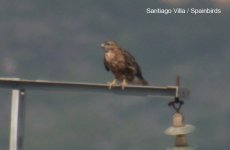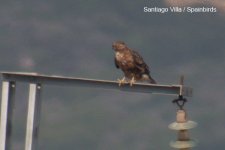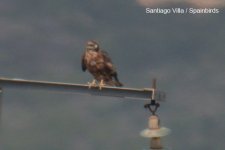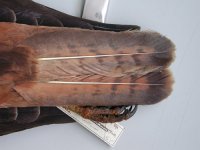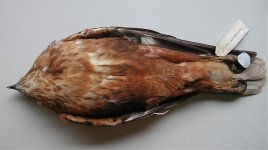Spainbirds
Santi - Spainbirds
Hi all,
I have been very busy in the last days and I couldn't keep with my idea to send you a daily report of the things we are seeing in the Straits. Anyway I will try to write a few words about the last three days.
Day 13: Palmones Bay and Alcornocales Natural Park
Cloudy but nice temperature in the morning near Algeciras. In the Palmones Bay we had a few species of waders including Oystercatcher, new bird for our trip, three Ospreys at the same time, Kingfisher, Spoonbill and White Storks. The weather at los Alcornocales was worse than expected and we had some rains for part of the evening. Here we had Firecrest, Great Spotted Woodpecker, Common Redstart, Northern Wheatear and quite a few raptors after the rain such as a party of 10 Egyptian Vultures, Sparrowhawks, several parties of Black Kites, Short-toed Eagles, Honey Buzzards and Booted Eagles. It seemed there were some rains in the watchpoints between Algeciras and Tarifa and the gliding species came to the Alcornocales.
Day 14: Bolonia - Cazalla - Algarrobo - Sierra de la Plata
Western winds today. In the morning we travelled near Bolonia where we tried for Rufous Bush Chat with no success however we had good numbers of Black Kites, Alpine Swifts and a single Black-eared Wheatear. Then we decided to move to Cazalla where we had an spectacular day with raptors everywhere and a couple of parties of Black Storks. Several Marsh Harriers, a Hobby and Montagu's Harriers were also seen but the most exciting moment was when a possible vulpinus race of Common Buzzard flew up into the valley and then perched in a electricity pylon. I managed to take some pictures before the bird flew (see attached files). Then I saw the upper tail pattern with a terminal dark band and a rufous tone which turned to white closer to the base of the tail. Although right identification between the cirtensis ssp of Long-legged Buzzard and the vulpinus race of Common Buzzard is far to be easy I would say quite sure that it was a vulpinus.
In the Algarrobo everything was very quiet but howerver we saw our second Rüepell's Vulture of the trip.Then we moved to Sierra de la Plata where we had a nice end seeing Iberian Green Woodpecker, Crag Martin, Blue Rock Thrush, three Sparrowhawks chasing a young Montagu's Harrier and an adult Griffon Vulture feeding a juvenile in the cliffs.
Day 15: Santuario - Los Lances beach - Cazalla - Algarrobo
East winds quite strong specially at Cazalla. We started the day in Santuario having a dozen of Griffon Vultures on the ground and many more in the air but we missed here Rüepell's Vulture, very often seen in the feeding station join Griffons. In los Lances amazing views of flocks of Black Kites, Honey Buzzards, a party of 26 Black Storks, Short-toed Eagles and of course Booted Eagles. Off shore we had Cory's and Balearic Shearwaters, Northern Gannets and Sandwich Terns, no signs of Lesser Crested Terns. In the beach itself good variety of waders including Kentish and Greater Ringed Plovers, Bar-tailed Godwits. Grey Plover, Turnstone, Sanderling, Dunlin and Curlew Sandpipers.
At Cazalla not many birds but all quite well seen including Egyptian Vultures. After an hour and a half here we decided to move to Algarrobo where the numbers of Booted Eagles were absolutely amazing. Dark, intermediate and light morphs everywhere! Unfortunately we had to come back to Málaga where this trip ends. I will come back with an American Birding Association group on monday. I will let you know then the changes in the migration.
Cheers,
Santiago Villa
www.spainbirds.com
I have been very busy in the last days and I couldn't keep with my idea to send you a daily report of the things we are seeing in the Straits. Anyway I will try to write a few words about the last three days.
Day 13: Palmones Bay and Alcornocales Natural Park
Cloudy but nice temperature in the morning near Algeciras. In the Palmones Bay we had a few species of waders including Oystercatcher, new bird for our trip, three Ospreys at the same time, Kingfisher, Spoonbill and White Storks. The weather at los Alcornocales was worse than expected and we had some rains for part of the evening. Here we had Firecrest, Great Spotted Woodpecker, Common Redstart, Northern Wheatear and quite a few raptors after the rain such as a party of 10 Egyptian Vultures, Sparrowhawks, several parties of Black Kites, Short-toed Eagles, Honey Buzzards and Booted Eagles. It seemed there were some rains in the watchpoints between Algeciras and Tarifa and the gliding species came to the Alcornocales.
Day 14: Bolonia - Cazalla - Algarrobo - Sierra de la Plata
Western winds today. In the morning we travelled near Bolonia where we tried for Rufous Bush Chat with no success however we had good numbers of Black Kites, Alpine Swifts and a single Black-eared Wheatear. Then we decided to move to Cazalla where we had an spectacular day with raptors everywhere and a couple of parties of Black Storks. Several Marsh Harriers, a Hobby and Montagu's Harriers were also seen but the most exciting moment was when a possible vulpinus race of Common Buzzard flew up into the valley and then perched in a electricity pylon. I managed to take some pictures before the bird flew (see attached files). Then I saw the upper tail pattern with a terminal dark band and a rufous tone which turned to white closer to the base of the tail. Although right identification between the cirtensis ssp of Long-legged Buzzard and the vulpinus race of Common Buzzard is far to be easy I would say quite sure that it was a vulpinus.
In the Algarrobo everything was very quiet but howerver we saw our second Rüepell's Vulture of the trip.Then we moved to Sierra de la Plata where we had a nice end seeing Iberian Green Woodpecker, Crag Martin, Blue Rock Thrush, three Sparrowhawks chasing a young Montagu's Harrier and an adult Griffon Vulture feeding a juvenile in the cliffs.
Day 15: Santuario - Los Lances beach - Cazalla - Algarrobo
East winds quite strong specially at Cazalla. We started the day in Santuario having a dozen of Griffon Vultures on the ground and many more in the air but we missed here Rüepell's Vulture, very often seen in the feeding station join Griffons. In los Lances amazing views of flocks of Black Kites, Honey Buzzards, a party of 26 Black Storks, Short-toed Eagles and of course Booted Eagles. Off shore we had Cory's and Balearic Shearwaters, Northern Gannets and Sandwich Terns, no signs of Lesser Crested Terns. In the beach itself good variety of waders including Kentish and Greater Ringed Plovers, Bar-tailed Godwits. Grey Plover, Turnstone, Sanderling, Dunlin and Curlew Sandpipers.
At Cazalla not many birds but all quite well seen including Egyptian Vultures. After an hour and a half here we decided to move to Algarrobo where the numbers of Booted Eagles were absolutely amazing. Dark, intermediate and light morphs everywhere! Unfortunately we had to come back to Málaga where this trip ends. I will come back with an American Birding Association group on monday. I will let you know then the changes in the migration.
Cheers,
Santiago Villa
www.spainbirds.com
Attachments
Last edited:




